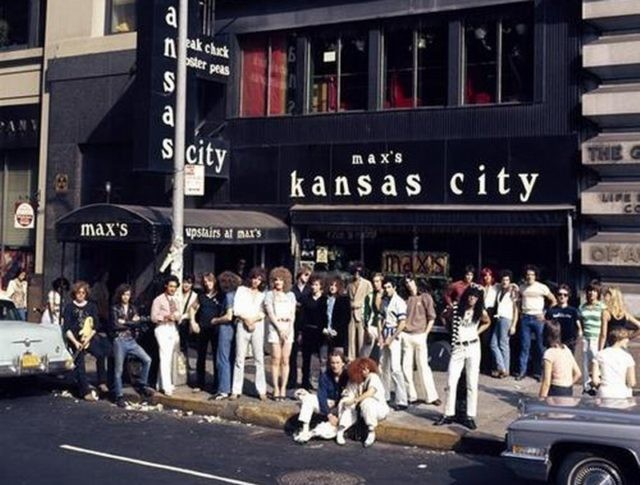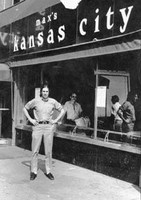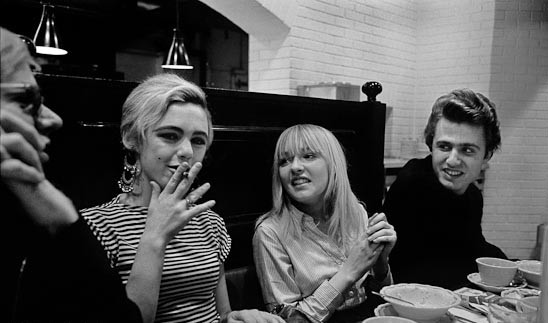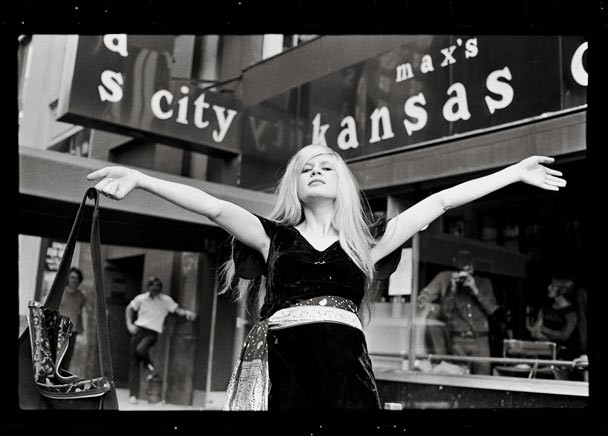Max's Kansas City (1965-1982)
Introduction
Text-to-speech Audio
Images
Max's in its heyday

Mickey Ruskin

Andy Warhol, Edie Sedgwick, Bibbe Hansen, and Gerard Malanga in Max's back room

Andrea Feldman in front of the club

Backstory and Context
Text-to-speech Audio
The legendary restaurant/bar/music venue, Max's Kansas City, opened in 1965. The club belonged to Mickey Ruskin, a restauranteur whose earlier efforts had catered to writers and artists. Always a supporter of artists, Ruskin envisioned the place as a haven for creative types, many of whom struggled with money and to find a place where they felt welcomed.
The origin of the name is somewhat mysterious, as the club involved no one named Max and had no connection to Kansas City. One possible explanation came from Ruskin's friend Joel Oppenheimer, who suggested, when told that Ruskin wanted to open a steak house, that he call it something with Kansas City in the name because when he was a child, all steak houses were similarly named. He also suggested the name Max, arguing "Wouldn't you eat at a place called Max's?"
When Max's opened, many of the clientele Ruskin cultivated through his earlier ventures followed him to the new restaurant. Unfortunately, the loyal following he developed among Greenwich Village writers and artists was not enough to keep the new business going. Shortly after Max's opening, however, Andy Warhol became a regular, along with the artists, actors, and oddballs with whom he surrounded himself. Becoming the favored haunt of Warhol and his coterie turned Max's Kansas City into one of the city's most popular nightspots.
Though more famous as a bar and music venue, Max's was also a restaurant. Ruskin, who apparently always had a soft spot for artists, frequently fed his clientele without charging them, knowing that it might be their only meal of the day. Lou Reed once remarked that he might have starved, if not for Ruskin feeding him daily for three years. Others settled bar tabs by trading their art, with Andy Warhol even settling a more than $700 tab by trading a piece of art identified simply as "Marilyn."
Gradually, Max's became the place to see and be seen, especially for those who found a way into the iconic back room. It was there that Warhol and his entourage, including Candy Darling, Edie Sedgwick, and Niko held court. (There is a famous reference to Candy in the back room in Lou Reed's "Walk on the Wild Side.) Reed, Iggy Pop, and David Bowie were just a few of the club's regulars.
Upstairs, bands that would in some cases go on to be among the biggest names in music performed. The Velvet Underground performed often, as did the New York Dolls. A young, nearly unknown Bruce Springsteen performed, as well as Bonnie Raitt, Bachman Turner Overdrive, Waylon Jennings, Willie Nelson, and Gram Parsons. In 1972, an unheard-of Boston band called Aerosmith, who weren't originally scheduled to play on that particular night, performed in front of Columbia Records president Clive Davis and got their first contract as a result. Max's was, according to Aerosmith lead singer, Steven Tyler, "that kind of place...it was like lighting a whole pack of Black Cat firecrackers all at once and throwing it in the room."
Despite the popularity of the club, Ruskin closed its doors in 1974. The following year, however, Tommy Dean Mills reopened Max's. In its second incarnation, much of the original clientele moved on to other haunts, and the reopened Max's became more of a punk venue. In fact, Max's is often cited as the birthplace of the American punk scene. The reborn Max's hosted some of the biggest names in punk music, including the Ramones, Blondie, New York Dolls, and Wayne County & the Electric Chairs. It also hosted the B-52s and Madonna before either was famous.
The club closed its doors permanently on New Years' Eve of 1981. There were attempts--mostly misguided--to reopen Max's in subsequent years, but none were successful. Micky Ruskin died in 1983 and his widow oversees the Max's Kansas City Project, a nonprofit devoted to the arts community. The building that once housed the legendary club is now home to a deli.
Cite This Entry
Woodham, Rebecca and Clio Admin. "Max's Kansas City (1965-1982) ." Clio: Your Guide to History. September 7, 2020. Accessed March 27, 2025. https://theclio.com/entry/113967
Sources
Max's Kansas City , Nostalgia Central . Accessed September 6th 2020. https://nostalgiacentral.com/music/artists-l-to-z/artists-m/maxs-kansas-city/.
From Clive Davis to Guitar Hero Aerosmith, Max's Kansas City . Accessed September 6th 2020. http://maxskansascity.com/classic/aerosmith/.
Seabrook, John . The Back Room , The New Yorker . August 23rd 2010. Accessed September 6th 2020. https://www.newyorker.com/magazine/2010/08/30/the-back-room.
About , Max's Kansas City . Accessed September 6th 2020. http://maxskansascity.com/about/.

